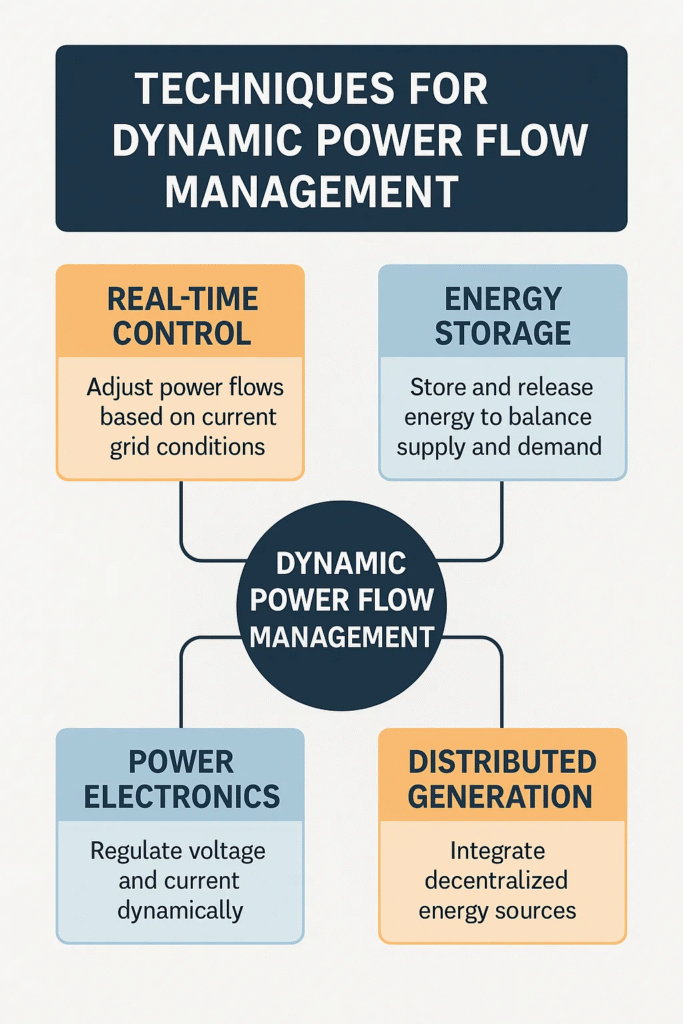🔌 Introduction
Picture yourself in the heart of a city on a warm summer afternoon. Every household has its air conditioning on, workplaces are illuminated, factories are functioning at full capacity, and electric vehicles are connected, charging quietly. In the background, a intricate dance is taking place — electricity is being skillfully directed from power plants, solar panels, wind farms, and batteries to locations where it is required.
This quiet coordination is referred to as Dynamic Power Flow Management — the real-time regulation of electricity distribution within a power network. It’s crucial to maintain balance, reliability, efficiency, and safety in today’s complex energy systems.
In this post, we will examine:
Dynamic power flow management refers to the real-time regulation and optimization of electrical energy distribution within a grid.
The importance of modern energy systems.
The essential methods and tools utilized
Practical uses and upcoming developments in the real world
Whether you’re an engineer, energy lover, student, or merely inquisitive — this article will provide you with a straight forward, hands-on grasp of how the grid operates, evolves, and responds.
⚙️ What Is Power Flow Management?
In every electrical power network — whether it’s a city or a single microgrid — electricity must be managed:
From the sources it originates(energy facilities, renewable energy)
To the places it’s required(residences, companies, sectors)
Ensuring the system remains stable, secure, and efficient
The management of that flow of power — in both magnitude and direction — is crucial, particularly when various power sources and loads are present.
Dynamic Power Flow Management involves real-time adjustments of this flow through data, software, and control systems.
It surpasses the conventional, static-grid system where energy moves in a single direction (generation → transmission → distribution → load). Rather, it considers the grid as a vibrant entity, responding immediately to fluctuations in supply and demand, equipment failures, and erratic renewable sources such as solar and wind.
🔌 Why Dynamic Power Flow Management Matters More Today
Let’s analyze it.
🔋 1. Rise of Renewable Energy
Wind and solar energy do not produce electricity at an even pace. Their output is influenced by the weather—at times it can be unpredictable. Controlling this variability necessitates balancing flow in real-time.
🚗2.Expansion of Distributed Energy Resources(DERs)
Power is now produced at numerous small locations throughout the grid, ranging from roof top solar to electric vehicles. It’s a reciprocal relationship — houses not only use energy, but they can also send some back.
🧠3.Intelligent Grids Require Intelligent Flow
Thanks to digitalization, sensors, and smart meters being ubiquitous, we now have instant insight into the grid. This creates opportunities for real-time dynamic management — but solely if appropriate flow strategies are implemented.
Unregulated power flows result in:
Over burdened lines
Voltage dips or spikes
Power outages
⚙️ Core Techniques for Dynamic Power Flow Management
Now, let’s examine the technical techniques employed to track and manage the flow of electricity within the grid.
1. Power Flow Analysis (Load Flow Studies)
To manage power flow, you must first grasp it.
Load flow analyses replicate the operation of an electrical network under different circumstances, assessing:
Voltages at the bus
Active and reactive power at every location
Current on lines and associated losses
Voltage phase angles
They employ iterative techniques such as:
Newton-Raphson Method
Gauss-Seidel Method
Rapidly Decoupled Approach
In a changing setting, these computations are executed continuously or regularly, enabling instant modifications
2. FACTS (Flexible AC Transmission Systems)
These are devices based on power electronics that can manage different facets of power flow.
A few instance sare:
UPFC (Unified Power Flow Controller): Manages voltage, impedance, and phase angle — the ultimate solution for flow regulation.
TCSC (Thyristor Controlled Series Capacitor): Modifies line impedance.
What Their Actions Are:
Redirect energy during traffic overload.
Enhance transmission capacity
Keep voltage and frequency stable.
Dynamically adjust loads
3. Real-Time Monitoring and SCADA Systems
SCADA (Supervisory Control and Data Acquisition) systems serve as the power grid’s eyes and ears.
They offer:
Real-time information on voltage, current, power, and frequency
Fault or overload alarm systems
Control panels for engineers
Contemporary SCADA systems are linked to:
PMUs (Phasor Measurement Units): Rapid voltage and angle detectors.
RTUs (Remote Terminal Units): Devices for collecting data in the field
Collectively, these enable operators to modify switches, redirect loads, and quickly isolate faults
4. Demand Response and Load Shifting
At times, overseeing power flow involves not only transferring electricity but also controlling usage.
Via demand response (DR):
Consumers consent to lessen or alter consumption during high-demand periods.
This aids in smoothing out demand surges and alleviating stress on the grid.
DR systems employ:
Intelligent meters
Tariffs based on time of use
Automated devices(such as intelligent thermostats and electric vehicle chargers)
This minimizes the requirement for emergency generation and enables improved flow distribution
5. Energy Storage Systems (Batteries, Flywheels)
Batteries notonly store energy butalsoregulate flow instantaneously.
When demand spikes:
Release batteries to sustain voltage and provide power.
When availability is abundant:
Replenish batteries to capture surplus production.
Storage assists:
Avoid reduction of renewable energy sources
Stabilize the frequency.
Assist black start situations
6. Microgrid Controllers
In microgrids (small, localized grids with their own energy sources), an intelligent controller manages the flow of electricity by making decisions:
When to employ local generation
When to pull from or transfer to the primary grid
Ways to maintain essential loads operational during outages
Microgrid controllers serve as the “brains” for the dynamic local flow
7. Optimal Power Flow (OPF)
This is a sophisticated mathematical method employed to enhance power flow while taking into account:
Generator restrictions
Line through put
Voltage limitations
Operating expenses
OPF is frequently utilized in:
Dispatch based on market principles
Economic load allocation
Forecasting and managing renewable resources
It’s akin to managing electricity flow — identifying the most economical and secure route for each kilowatt
8. AI and Machine Learning in Flow Prediction
Contemporary flow management employs algorithms based on data to:
Predict demand and production
Identify unusual trends
Anticipate traffic jams or disruptions.
Recommend ideal allocation.
Machine learning improves real-time decision-making by acquiring knowledge from:
Data from the past
Meteorological predictions
Topology of a grid

🔌 Case Studies: Real-World Applications
🏙️ 1. New York Independent System Operator (NYISO)
They utilize real-time flow predictions and FACTS devices to flexibly modify power paths, ensuring balanced distribution across urban and rural areas with significant renewable integration
🌬️ 2. Denmark’s Wind Grid
Denmark harnesses more than 40% of its energy from wind, utilizing battery storage, dynamic regulation, and demand response to manage generation variability
🏭 3. Industrial Microgrids
Factories in India and Africa utilize AI-driven microgrid controllers to determine whether to use diesel generators, solar PV, or battery backup — ensuring seamless operations
🧠 Challenges in Dynamic Power Flow Management
While the benefits are clear, there are still real-world hurdles:
- Data Overload
Smart grids generate massive data. Processing and reacting in real time is a challenge. - Cybersecurity
More control means more entry points. Secure communication and authentication are critical.
3. Interoperability
Not all components speak the same language. Integrating diverse equipment is tough.
4. Cost
Advanced technologies (like FACTS or batteries) are expensive. ROI takes time.
🔮 Future Trends in Power Flow Management
🌐 1. Grid Digital Twins
A real-time simulation of the grid that mirrors the physical system. Operators can test flow changes before applying them.
🧠 2. Decentralized Control
Instead of top-down control, AI-based nodes make local decisions — a “swarm intelligence” approach.
🔄 3. Vehicle-to-Grid (V2G)
EVs not just consume power — they send it back. Managing millions of EVs becomes part of flow management.
☁️ 4. Cloud-Based SCADA
Bringing traditional control systems to the cloud for better access, flexibility, and analytics.
🧾 Conclusion
Dynamic power flow management is more than just wires and switches — it’s about managing the heartbeat of a nation’s energy system.
In a world moving towards clean energy, electrification, and decentralization, electricity must flow flexibly, intelligently, and instantly.
